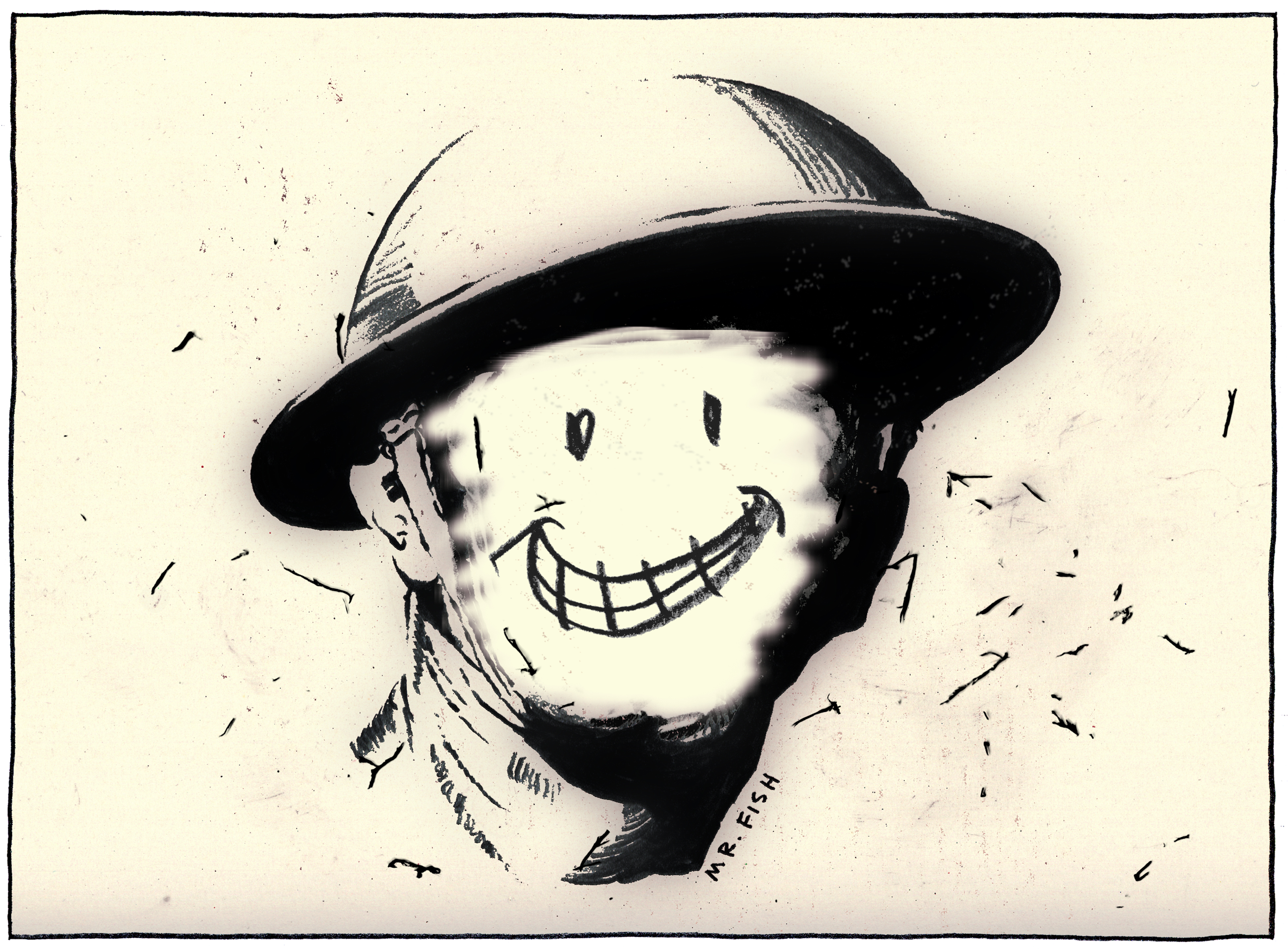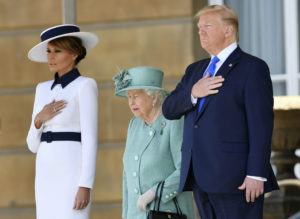Peter Jackson’s Cartoon War
Though the dark futility and carnage of our current wars are rarely publicly acknowledged, we should at least be able to confront the suicidal idiocy of World War I. Mr. Fish / Truthdig
Mr. Fish / Truthdig
When director-producer Peter Jackson’s World War I film, “They Shall Not Grow Old,” which miraculously transforms grainy, choppy black-and-white archival footage from the war into a modern 3D color extravaganza, begins, he bombards us with the clichés used to ennoble war. Veterans, over background music, say things like “I wouldn’t have missed it,” “I would go through it all over again because I enjoyed the service life” and “It made me a man.” It must have taken some effort after the war to find the tiny minority of veterans willing to utter this rubbish. Military life is a form of servitude, prolonged exposure to combat leaves you broken, scarred for life by trauma and often so numb you have difficulty connecting with others, and the last thing war does is make you a man.
Far more common was the experience of the actor Wilfrid Lawson, who was wounded in the war and as a result had a metal plate in his skull. He drank heavily to dull the incessant pain. In his memoirs “Inside Memory,” Timothy Findley, who acted with him, recalled that Lawson “always went to bed sodden and all night long he would be dragged from one nightmare to another—often yelling—more often screaming—very often struggling physically to free himself of impeding bedclothes and threatening shapes in the shadows.” He would pound the walls, shouting “Help! Help! Help!” The noise, my dear—and the people.
David Lloyd George, wartime prime minister of Britain, in his memoirs used language like this to describe the conflict:
… [I]nexhaustible vanity that will never admit a mistake … individuals who would rather the million perish than that they as leaders should own—even to themselves—that they were blunderers … the notoriety attained by a narrow and stubborn egotism, unsurpassed among the records of disaster wrought by human complacency … a bad scheme badly handled … impossible orders issued by Generals who had no idea what the execution of their commands really meant … this insane enterprise … this muddy and muddle-headed venture. …
The British Imperial War Museum, which was behind the Jackson film, had no interest in portraying the dark reality of war. War may be savage, brutal and hard, but it is also, according to the myth, ennobling, heroic and selfless. You can believe this drivel only if you have never been in combat, which is what allows Jackson to modernize a cartoon version of war.
The poet Siegfried Sassoon in “The Hero” captured the callousness of war:
“Jack fell as he’d have wished,” the Mother said, And folded up the letter that she’d read. “The Colonel writes so nicely.” Something broke In the tired voice that quavered to a choke. She half looked up. “We mothers are so proud Of our dead soldiers.” Then her face was bowed.
Quietly the Brother Officer went out. He’d told the poor old dear some gallant lies That she would nourish all her days, no doubt. For while he coughed and mumbled, her weak eyes Had shone with gentle triumph, brimmed with joy, Because he’d been so brave, her glorious boy.
He thought how “Jack,” cold-footed, useless swine, Had panicked down the trench that night the mine Went up at Wicked Corner; how he’d tried To get sent home; and how, at last, he died, Blown to small bits. And no one seemed to care Except that lonely woman with white hair.
Our own generals and politicians, who nearly two decades ago launched the greatest strategic blunder in American history and have wasted nearly $6 trillion on conflicts in the Middle East that we cannot win, are no less egotistical and incompetent. The images of our wars are as carefully controlled and censored as the images from World War I. While the futility and human carnage of our current conflicts are rarely acknowledged in public, one might hope that we could confront the suicidal idiocy of World War I a century later.
Leon Wolff, in his book “In Flanders Fields: The 1917 Campaign,” writes of World War I:
It had meant nothing, solved nothing, and proved nothing; and in so doing had killed 8,538,315 men and variously wounded 21,219,452. Of 7,750,919 others taken prisoner or missing, well over a million were later presumed dead; thus the total deaths (not counting civilians) approach ten million. The moral and mental defects of the leaders of the human race had been demonstrated with some exactitude. One of them (Woodrow Wilson) later admitted that the war had been fought for business interests; another (David Lloyd George) had told a newspaperman: ‘If people really knew, the war would be stopped tomorrow, but of course they don’t—and can’t know. The correspondents don’t write and the censorship wouldn’t pass the truth.’
There is no mention in the film of the colossal stupidity of the British general staff that sent hundreds of thousands of working-class Englishmen—they are seen grinning into the camera with their decayed teeth—in wave after wave, week after week, month after month, into the mouths of German machine guns to be killed or wounded. There is no serious exploration of the iron censorship that hid the realities of the war from the public and saw the press become a shill for warmongers. There is no investigation into how the war was used by the state, as it is today, as an excuse to eradicate civil liberties. There is no look at the immense wealth made by the arms manufacturers and contractors or how the war plunged Britain deep into debt with war-related costs totaling 70 percent of the gross national product. Yes, we see some pictures of gruesome wounds, digitalized into color, yes, we hear how rats ate corpses, but the war in the film is carefully choreographed, stripped of the deafening sounds, repugnant smells and most importantly the crippling fear and terror that make a battlefield a stygian nightmare. We glimpse dead bodies, but there are no long camera shots of the slow agony of those dying of horrific wounds. Sanitized images like these are war pornography. That they are no longer jerky and grainy and have been colorized in 3D merely gives old war porn a modern sheen.
“When the war was not very active, it was really rather fun to be in the front line,” a veteran says in the film. “It was a sort of outdoor camp holiday with a slight spice of danger to make it interesting.”
Insipid comments like that defined the perception of the war at home. The clash between a civilian population that saw the war as “a sort of outdoor camp holiday” and those who experienced it led to profound estrangement. The poet Charles Sorley wrote: “I should like so much to kill whoever was primarily responsible for the war.” And journalist and author Philip Gibbs noted that soldiers had a deep hatred of civilians who believed the lies. “They hated the smiling women in the streets. They loathed the old men. … They desired that profiteers should die by poison-gas. They prayed to God to get the Germans to send Zeppelins to England—to make the people know what war meant.”
Military studies have determined that after 60 days of continuous combat, 98 percent of those who survive will have become psychiatric casualties. The common trait among the 2 percent who were able to endure sustained combat was a predisposition toward “aggressive psychopathic personalities.” Lt. Col. David Grossman wrote: “It is not too far from the mark to observe that there is something about continuous, inescapable combat which will drive 98 percent of all men insane, and the other 2 percent were crazy when they got there.”
The military cliques in American society are as omnipotent as they were in World War I. The symbols of war and militarism, then and now, have a quasi-religious aura, especially in our failed democracy. Our incompetent generals—such as David Petraeus, whose surges only prolonged the Iraq War and raised the casualty figures and whose idea to arm “moderate” rebels in Syria was a debacle—are as lionized as the pig-headed and vainglorious Gen. Douglas Haig, the British commander in chief, who resisted innovations such as the tank, the airplane and the machine gun, which he called “a much overrated weapon.” He believed the cavalry would play the decisive role in winning the war. Haig, in the Battle of the Somme, oversaw 60,000 casualties on the first day of the offensive, July 1, 1916. None of his military objectives were achieved. Twenty thousand lay dead between the lines. The wounded cried out for days. This did not dampen Haig’s ardor to sacrifice his soldiers. Determined to make his plan of bursting through the German lines and unleashing his three divisions of cavalry on the fleeing enemy, he kept the waves of assaults going for four months until winter forced him to cease. By the time Haig was done, the army had suffered more than 400,000 casualties and accomplished nothing. Lt. Col. E.T.F. Sandys, who saw 500 of his soldiers killed or wounded on the first day at the Somme, wrote two months later, “I have never had a moment’s peace since July 1st.” He then shot himself to death in a London hotel room. Joe Sacco’s illustrated book “The Great War,” a 24-foot-long wordless panorama that depicts the first day of the Battle of Somme, reveals more truth about the horror of war than Jackson’s elaborate restoration of old film.
The military historian B.H. Liddell Hart, who served in the war, wrote in his diary:
He [Haig] was a man of supreme egoism and utter lack of scruple—who, to his overweening ambition, sacrificed hundreds of thousands of men. A man who betrayed even his most devoted assistants as well as the Government which he served. A man who gained his ends by trickery of a kind that was not merely immoral but criminal.
The American attorney Harold Shapiro, following World War I, examined the medical records of the Army on behalf of a disabled veteran. He was appalled at the reality these records elucidated and the misperception of the war within the public. The medical descriptions, he wrote, rendered “all that I had read and heard previously as being either fiction, isolated reminiscence, vague generalization or deliberate propaganda.” He published a book in 1937 titled “What Every Young Man Should Know About War.” It was pulled from circulation when the United States entered World War II and never reissued. It was the model for my book “What Every Person Should Know About War.”
Shapiro wrote in his chapter “Mental Reactions”:
Q: What may happen to me after I bayonet my enemy in the face?
You may develop an hysterical tic—quick, sudden, convulsive spasms of twitching of your own facial muscles.
Q: What may happen to me after I bayonet my enemy in the abdomen?
You may be seized with abdominal contractions.
Q: What may happen to me following particularly horrible sights?
You may be seized with hysterical blindness.
Q: What may happen to me if I find the cries of the wounded unbearable?
You may develop hysterical deafness.
Q: What may happen to me should I be detailed to burial parties?
You may develop anosmia (loss of your sense of smell).
The German pacifist Ernst Friedrich collected 200 photographs of gruesome wounds, piles of corpses in mass graves, the hanging and executions of deserters—their families were told they had “died of wounds”—and battlefield atrocities censored from the public in his 1924 book, “WAR Against WAR!” He juxtaposed the images against the propaganda that romanticized the conflict. His 24 close-ups of soldiers with grotesquely disfiguring facial wounds remain difficult to view. Friedrich was arrested when the Nazis came to power in 1933, his book was banned and his Anti-War Museum closed. A picture of a nearly naked soldier dead in a trench in his book reads: “Mothers! This was the fate of your sons in the war; first murdered, then robbed to the skin and then left as grub for animals.”
Honestly examining past wars gives us the ability to understand current wars. But this is a herculean struggle. The public is fed, and yearns for, the myth. It is empowering and ennobling. It celebrates supposed national virtues and military prowess. It allows an alienated population to feel part of a national collective engaged in a noble crusade. The celebration of the destructive force of our weaponry makes us feel personally empowered. All wars, past and present, are effectively shrouded in this myth. Those who decried the waste and carnage, such as Keir Hardie, the head of the Independent Labour Party, were jeered in the streets. Adam Hochschild’s book “To End All Wars” details the struggle by pacifists and a handful of journalists and dissidents during the war to make the truth known and who were mocked, silenced and often jailed.
“Few of us can hold on to our real selves long enough to discover the momentous truths about ourselves and this whirling earth to which we cling,” wrote J. Glenn Gary, a combat veteran of World War II, in “The Warriors: Reflections on Men in Battle.” “This is especially true of men in war. The great god Mars tries to blind us when we enter his realm, and when we leave he gives us a generous cup of the waters of Lethe to drink.”
Jackson closes the film with an army ditty about prostitution. “You might forget the gas and shell,” the song goes, “but you’ll nev’r forget the Mademoiselle! Hinky-dinky, parlez-vous?”
Tens of thousands of girls and women, whose brothers, fathers, sons and husbands were dead or crippled, and whose homes often had been destroyed, became impoverished and often homeless. They were easy prey for the brothels, including the military-run brothels, and the pimps that serviced the soldiers. There is nothing amusing or cute about lying on a straw mat and being raped by as many as 60 men a day, unless you are the rapist.
“Give sorrow words,” William Shakespeare reminded us, “The grief that does not speak whispers the o’erfraught heart and bids it break.”
It is fortunate all the participants in the war are dead. They would find the film another example of the monstrous lie that denied their reality, ignored or minimized their suffering and never held the militarists, careerists, profiteers and imbeciles who prosecuted the war accountable. War is the raison d’être of technological society. It unleashes demons. And those who profit from these demons, then and now, work hard to keep them hidden.
Your support matters…
Independent journalism is under threat and overshadowed by heavily funded mainstream media.
You can help level the playing field. Become a member.
Your tax-deductible contribution keeps us digging beneath the headlines to give you thought-provoking, investigative reporting and analysis that unearths what's really happening- without compromise.
Give today to support our courageous, independent journalists.





You need to be a supporter to comment.
There are currently no responses to this article.
Be the first to respond.